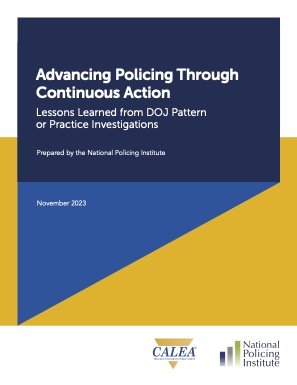By Thomas E. Christoff, Shelby Hickman, Zoë Thorkildsen, Monique Jenkins, Jennifer Lafferty, Melissa Gutierrez and Heleana Melendez
Police departments have evolved since the advent of modern policing in the early 19th century, with their roles and purposes constantly changing to meet the needs of the communities they serve. In that time, technology (defined here as tools or systems that enhance law enforcement’s ability to perform its duties) has also evolved, particularly since the 1990s, and police departments are increasingly incorporating modern technology into their daily functions. One of the earliest instances of technology use by police departments was the adoption of the police radio, which allowed officers to have constant communication with one another while patrolling different beats. Since the adoption of the police radio, technology has advanced in ways that benefit not only officers but also the public. Technology provides police departments with the ability to improve accountability and transparency, improve the quality of investigations, effectively allocate resources, and improve levels of trust with their communities. However, given the rapid pace of technological advancement in policing, a review of the various tools presently used in police departments is needed to better understand what is effective in achieving common goals. Using a systematic review framework, the CNA team searched relevant literature examining police, technology and innovation, public safety, crime reduction, and community relationships and identified 1,500 articles for initial review. These articles included academic research, government publications, unpublished studies, and other grey literature. The team completed a more in-depth review of the identified articles, using nine criteria to determine eligibility for this systematic review. The in-depth review yielded 98 articles eligible for the final review. These 98 studies examined police departments’ use of various technologies such as body-worn cameras (BWC), information technology (IT) (e.g., CompStat), closed-circuit television (CCTV) cameras, spatial analysis software, uncrewed aircraft systems (UAS, often called drones), license plate readers (LPR), social media and other public websites, mobile phones or computers, and gunshot detection. Final review included literature coding, which identified the following information from the articles: • Department or agency discussed • Agency type • Research question • Data source • Sample or respondents • Technology (category and specific) • Study type • Evaluation type • Research approach • Research methods • Study included cost-benefit analysis (CBA) • Outcomes (category and specific) The purpose of the present study is to provide a guide for employing any new technology, discuss insights on technologies currently being used in law enforcement agencies in the United States, and summarize findings and outcomes from the articles reviewed. It also provides a broader discussion on lessons learned for agencies implementing a new technology, including how to determine a need for technology, positive practices when implementing the technology, and anticipated benefits for modern technologies. In addition, it discusses how law enforcement can use technology as a tool to improve crime prevention, investigations and case clearances, accountability and transparency, and community relations. Technology has the potential to aid crime analysts in identifying crime trends, detectives in making arrests, and agencies in maintaining officer standards and building a stronger level of trust between communities and the officers who serve them. Both researchers and police departments therefore have the responsibility to take initiative in reviewing tools and practices to ensure department resources are effectively used.
Washington, DC: Office of Community Oriented Policing Services. 2024.68p.





















